




Your support is critical to our success.
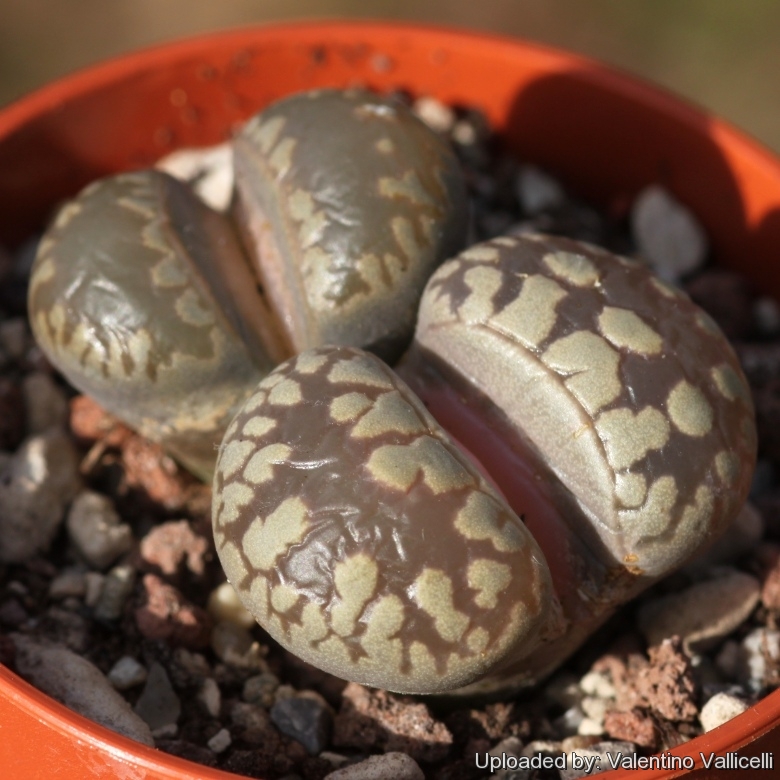
SH531 East Brakfontein (MG 1686.14)
Origin and Habitat: Endemic to a very small area North-North-West of Loeriesfontein, South Africa.
Habitat: The substrate comprises mainly gneiss and granite rocks. The plants grows ether on open places and under bushes. Background colours: Grey-white, pale brown or greenish.
Synonyms:
Lithops otzeniana Nel
Kakteenkunde (8) 123-127, 1937
Synonymy: 4
- Lithops otzeniana Nel
- Lithops otzeniana C128 TL: 35 km NNW of Loeriesfontein, South Africa
- Lithops otzeniana C280 45 km NNW of Loeriesfontein, South Africa
- Lithops otzeniana C350 40 km NNW of Loeriesfontein, South Africa
- Lithops otzeniana C128A TL: 35 km NNW of Loeriesfontein, South Africa cv. Aquamarine
- Lithops otzeniana cv. Cesky Granat Pavelka
Description: Lithops otzenianaSN|13266]]SN|13266]] usually forms small groups with 2-5 heads but occasionally with up to 25 heads (especially in cultivation). It is a very peculiar species easily distinguished for its translucent greenish-olive top with lighter raised, scalloped islands around the edges.
Cole numbers: C128, C280, C350
Bodies (paired leaves): Up to 3 cm hight and 20-30 mm x 15-20 mm wide, cordate truncate in profile, with a relative deep fissure and lobes half-moon shaped more or less divergent. Face: More or less elliptical smooth to moderately rugose and more or less convex. Margin: Very distinct with elevated teeth-like rounded peninsulas.
Islands: Usually few but sometime numerous mostly included among the margins peninsulas. Colour light grey with shades of pink, cream, green or blue. Windows: Mostly occluded with broad to narrow channel. Colour: Greenish, olive-green or bluish green, translucent sometime with white or pink shadows. Rubrication: Not present.
Flowers: Yellow with a white throat, about 1,5-3,5 cm diameter.
Blooming season: Early autumn.
Fruits: Mostly 5-chambered capsules.
Subspecies, varieties, forms and cultivars of plants belonging to the Lithops otzeniana group
 Lithops otzeniana Nel: Top surfaces with large clear windows of greenish olive-green colour or tinged with violet,
Lithops otzeniana Nel: Top surfaces with large clear windows of greenish olive-green colour or tinged with violet,
with lighter raised, half-moon shaped islands around the edges. Lithops otzeniana C128A TL: 35 km NNW of Loeriesfontein, South Africa cv. Aquamarine: This cultivar comes from a unique specimen collected by Collected by D.T. & N.A. Cole. Its peculiarity are the dark greyish-green windows with pale creamy-green margin, indentation and island. Apart for the colour the plant is identical to the standard form. Origin: North West of Loeriesfontein.
Lithops otzeniana C128A TL: 35 km NNW of Loeriesfontein, South Africa cv. Aquamarine: This cultivar comes from a unique specimen collected by Collected by D.T. & N.A. Cole. Its peculiarity are the dark greyish-green windows with pale creamy-green margin, indentation and island. Apart for the colour the plant is identical to the standard form. Origin: North West of Loeriesfontein. Lithops otzeniana C128 TL: 35 km NNW of Loeriesfontein, South Africa: Large open jagged window.
Lithops otzeniana C128 TL: 35 km NNW of Loeriesfontein, South Africa: Large open jagged window. Lithops otzeniana C280 45 km NNW of Loeriesfontein, South Africa: light pink surface, jagged
Lithops otzeniana C280 45 km NNW of Loeriesfontein, South Africa: light pink surface, jagged Lithops otzeniana C350 40 km NNW of Loeriesfontein, South Africa: bold scallops
Lithops otzeniana C350 40 km NNW of Loeriesfontein, South Africa: bold scallops- Lithops otzeniana cv. Cesky Granat Pavelka: Similar in shape and size to the normal form but with a distinctive red colouring.
Notes: Lithops (a.k.a. Stone plants) reduce the surface area for water loss by means of burial, they grow entirely within the soil and only the leaf tips are at the level of the soil surface. This habit also reduce exposure to herbivores, since the leaves mimic the colour and even the texture of surrounding ground and stones. This camouflage allows them to escape detection and is a very effective strategy for escaping predation.
Bibliography: Major refences and further lectures
1) Heidrun E. K. Hartmann (2002) “Aizoaceae F – Z” Springer
2) Achim Hecktheuer (2008) “Mesembs, mehr als nur Lithops” Books on Demand GmbH Norderstedt. ISBN-13 978-3-8370-1724-3
3) Desmond T. Cole & Naureen A. Cole, Uwe Beyer, Yves Delange (2008) “Les Lithops” SUCCULENTES Spécial 2008 AIAPS (now Terra seca). ISSN 0258-5359
4) Desmond T. Cole & Naureen A. Cole (2005) “LITHOPS Flowering Stones” Cactus & Co. Libri. ISBN 88-900511-7-5 ISBN-13 978-88-900511-7-3
5) Yasuhiko Shimada (2001) “The Genus Lithops” Dobun Shoin. ISBN 4-8103-4066-X
6) Rudolf Heine (1986) “Lithops - Lebende Steine” Neumann Verlag. ISBN 3-7402-0000-6; ISBN-13 978-3-7402-0000-8
7) Bernd Schlösser (2000) “Lithops – Lebende Steine” Praktische Anleitung für die Zimmerkultur. BussinessPoint MEDIA. ISBN 3-934945-01-5; ISBN-13 978-3-934945-01-2
8) Steven A. Hammer (1999) “Lithops – Treasures of the veld” British Cactus and Succulent Society. ISBN 0-902-099-64-7; ISBN-13 978-0-902099-64-7
9) Desmond T. Cole (1988) “Lithops – Flowering Stones” Acorn Books CC. ISBN 0-620-09678-0; ISBN-13 978-0-620-09678-2
10) Rudolf Heine (1986) “Lithops – lebende Steine” Neumann Verlag. ISBN 3-7402-0000-6; ISBN-13 978-3-7402-0000-8
11) David L. Sprechman (1970) “Lithops” Associated University Presses, Inc. SBN 8386-6902-6
12) Gert Cornelius Nel (1946) “Lithops” Hortors Limited, South Africa
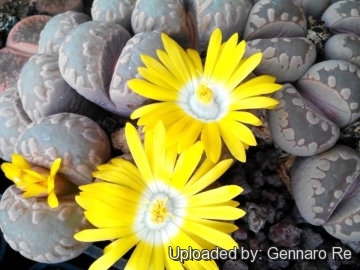
Lithops otzeniana Photo by: Gennaro Re
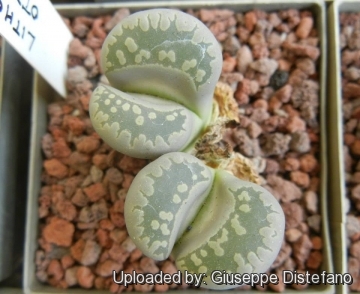
Lithops otzeniana Photo by: Giuseppe Distefano
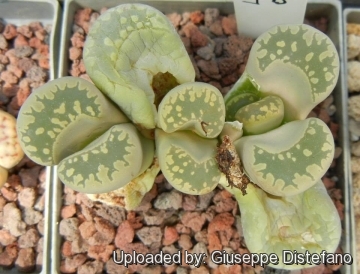
Lithops otzeniana Photo by: Giuseppe Distefano
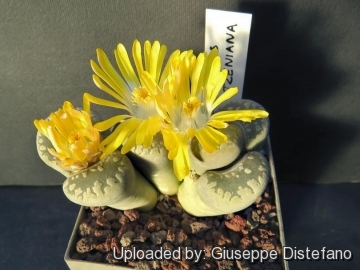
Lithops otzeniana Photo by: Giuseppe Distefano
Cultivation and Propagation: In general the Lithops are some of the world's most fascinating plants sought by succulent plants collector. Paying attention to the particular growing requirement of Lithops is especially important. If you provide the Lithops with the right conditions, they will reward you with their unique shape, size, colour and a proliferation of blooms in autumn. However, Lithops are tricky plants that are very particular about their growing conditions and require the right maintenance in order to keep happy. But don't be afraid even the best growers have plants that mysteriously dry up, or leave during the night. While Lithops are picky about their care, if you are patient and remember the basics, your efforts will be rewarded. Being small plants, a representative collection can be grown on a patio table, a sunny windowsill or a shelf in the greenhouse.
Growing rate: Slow growing for a mesemb.
Soil: They grow best in an open mineral, sandy-gritty soil and requires good drainage as they are prone to root rot. They can grow outdoor in sunny, dry, rock crevices (protection against winter wet is required) They can also be cultivated in alpine house, in poor, drained soil.
Repotting: They may stay in the same pot for many years. Plants grown in larger containers have frequently relatively poor flowers. Flowers might improve when the plants are given their own, small individual pots.
Watering They Require little water otherwise the epidermis breaks (resulting in unsightly scars). The basic cultivation routine is: Stop watering after flowering. Start watering after the old leaves are completely dry (usually late March or Early April). Water freely during the growing season, soak the compost fully but allow it to dry out between waterings. In the winter season the plant doesn’t need watering, the plant in this time extracts water from the outer succulent leaves, allowing them to shrivel away, relocating water to the rest of the plant and to the new leaves that form during this period. If grown in a container, bottom watering by immersing the container is recommended. Water sparingly only when warm, no water when cold. Nearly all problems occur as a result of overwatering and poor ventilation, especially when weather conditions are dull and cool or very humid. They must have very dry atmosphere.
Fertilization: Feed them once during the growing season with a fertilizer specifically formulated for cactus and succulents (high potash fertilizer with a dilute low nitrogen), including all micro nutrients and trace elements diluted to ½ the strength recommended on the label. They thrive in poor soils and need a limited supplies of fertilizer to avoid the plants developing excess vegetation, which is easily attacked by fungal diseases. Some growers fertilize frequently, some hardly ever. However, for the highly succulent mesembs, (Lithops, Conophytums, etc.) fertilization is not really necessary.
Light: They prefer a very bright situation and in winter they need the maximum amount of light you are able to give them, but keep more cool and partially shaded in summer. The only exception to this is seedlings in their first year that enjoy a shades place. Such tiny plants can easily get scorched or broiled and their appearance spoiled (this may not matter in the wild, where the Lithops have probably shrunk into the ground and becomes covered with sands). Outdoor (Lithops prefer full sun, with some shade in the hottest summer months. High levels of light are needed in autumn to flower and for good plant development. The low intensity of sun light during the growing season of this species generally prevents the white flower flowers from opening.
Special Advice: Lithops are best planted in a sunny and airy part of the greenhouse, and not too close to the glass roof or sides of the house as the plants can overheat during hot spells.
Hardiness: They require a minimum temperature 5°C (But will take a light frost and are hardy down to -7° C for short periods if they are in dry soil). USDA zones 9A – 11.
Uses: Container, rock garden.
Pests & diseases: Lithops may be attractive to a variety of insects, but plants in good condition should be nearly pest-free, particularly if they are grown in a mineral potting-mix, with good exposure and ventilation. Nonetheless, there are several pests to watch for:
- Red spiders: Red spiders may be effectively rubbed up by misting the vulnerable plants every day.
- Mealy bugs: Occasionally mealy bugs develop aerial into the new leaves and flowers with disfiguring results, but the worst types develop underground on the roots and are invisible except by their effects.
- Sciara Flies: Sciara flies are one of the major problems for seedlings. It is a good practice to mulch your seedlings with a layer of grit, which will strongly discourage the flies.
- Scales, thrips and aphids: They are rarely a problem.
- Rot: Root rot it is only a minor problem with mesembs if the plants are watered and “aired” correctly. If they are not, fungicides won't help all that much.
Remarks: After flowering in the autumn and extending through winter season the plant doesn’t need watering, but they will still be growing, the new bodies will be increasing in size extracting water from the outer succulent leaves, allowing them to shrivel away. In fact the plant in this time extracts water and nutrient stored in the outer succulent leaves, allowing them to dehydrate relocating the water to the rest of the plant and to the new leaves that form during this period until the old leaves are reduced to nothing more than "thin papery shells".
Propagation: Seed or (or rarely) cuttings. The small seeds can be sown in pots of fine, well-drained sand, any time during the spring and summer months when temperatures are warm. Cover the seeds with a very fine layer of grit and water from below with a fungicide to prevent damping off. For the first 3-4 days cover the pots with a sheet of glass/clear perspex to keep the humidity levels high. Remove the glass and replace it with light shadecloth and mist once or twice a day for the next two weeks after which most seeds should have germinated. From then on mistings can be reduced to every second and then every third day as the little plants grow. Take the cuttings from a grown-up mother plant. Each cutting must contain one or more heads along with a fraction of root and permit them to dry out a couple of days, lay the cuttings on the soil and insert the stem end partially into the soil. Try to keep the cutting somewhat upright so that the roots are able to grow downward. It is relatively difficult to root Lithops from cuttings and generally pointless as well, so quick are they from seed.
Comment: Improvement of Lithops characteristics: Some growers (but not all!!) think it is very intriguing to reinforce any characteristic of cultivated Lithops of by crossing two similar selected plants and then back-crossing with the mother plant. This way we can eventually get some interesting results. Of course, many of the nicest Lithops we grow in cultivation have already been selected over time. However many Lithops are already nice plants which can’t really be improved, on the other hand one could try to improve the colour or the markings etc. Now if we have two particular plants we may attempt to breed between them and can maybe get a whole improved population and then select some better offspring to continue the selection.
Seed production: Plants can be hand pollinated, using a small paint brush. Remember always to cross different clones as the plants are self-sterile. The seed will remain viable for many years provided it is stored in a cool dry place.
| Your Actions | |
|---|---|
| Back to Lithops index | |
| Back to Aizoaceae index | |
 |
Back to Succulents Encyclopedia index |
Privacy stantement - Terms and conditions - How to cite - About us - Feedback - Donate



